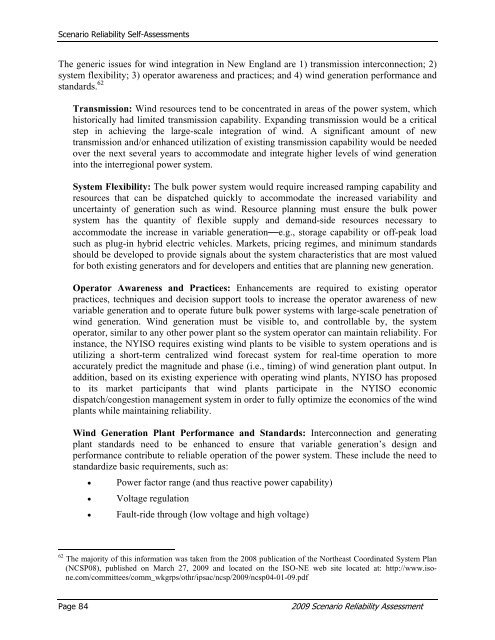2009 Scenario Reliability Assessment - NERC
2009 Scenario Reliability Assessment - NERC
2009 Scenario Reliability Assessment - NERC
- No tags were found...
Create successful ePaper yourself
Turn your PDF publications into a flip-book with our unique Google optimized e-Paper software.
<strong>Scenario</strong> <strong>Reliability</strong> Self-<strong>Assessment</strong>sThe generic issues for wind integration in New England are 1) transmission interconnection; 2)system flexibility; 3) operator awareness and practices; and 4) wind generation performance andstandards. 62Transmission: Wind resources tend to be concentrated in areas of the power system, whichhistorically had limited transmission capability. Expanding transmission would be a criticalstep in achieving the large-scale integration of wind. A significant amount of newtransmission and/or enhanced utilization of existing transmission capability would be neededover the next several years to accommodate and integrate higher levels of wind generationinto the interregional power system.System Flexibility: The bulk power system would require increased ramping capability andresources that can be dispatched quickly to accommodate the increased variability anduncertainty of generation such as wind. Resource planning must ensure the bulk powersystem has the quantity of flexible supply and demand-side resources necessary toaccommodate the increase in variable generation—e.g., storage capability or off-peak loadsuch as plug-in hybrid electric vehicles. Markets, pricing regimes, and minimum standardsshould be developed to provide signals about the system characteristics that are most valuedfor both existing generators and for developers and entities that are planning new generation.Operator Awareness and Practices: Enhancements are required to existing operatorpractices, techniques and decision support tools to increase the operator awareness of newvariable generation and to operate future bulk power systems with large-scale penetration ofwind generation. Wind generation must be visible to, and controllable by, the systemoperator, similar to any other power plant so the system operator can maintain reliability. Forinstance, the NYISO requires existing wind plants to be visible to system operations and isutilizing a short-term centralized wind forecast system for real-time operation to moreaccurately predict the magnitude and phase (i.e., timing) of wind generation plant output. Inaddition, based on its existing experience with operating wind plants, NYISO has proposedto its market participants that wind plants participate in the NYISO economicdispatch/congestion management system in order to fully optimize the economics of the windplants while maintaining reliability.Wind Generation Plant Performance and Standards: Interconnection and generatingplant standards need to be enhanced to ensure that variable generation’s design andperformance contribute to reliable operation of the power system. These include the need tostandardize basic requirements, such as:Power factor range (and thus reactive power capability)Voltage regulationFault-ride through (low voltage and high voltage)62 The majority of this information was taken from the 2008 publication of the Northeast Coordinated System Plan(NCSP08), published on March 27, <strong>2009</strong> and located on the ISO-NE web site located at: http://www.isone.com/committees/comm_wkgrps/othr/ipsac/ncsp/<strong>2009</strong>/ncsp04-01-09.pdfPage 84<strong>2009</strong> <strong>Scenario</strong> <strong>Reliability</strong> <strong>Assessment</strong>
















